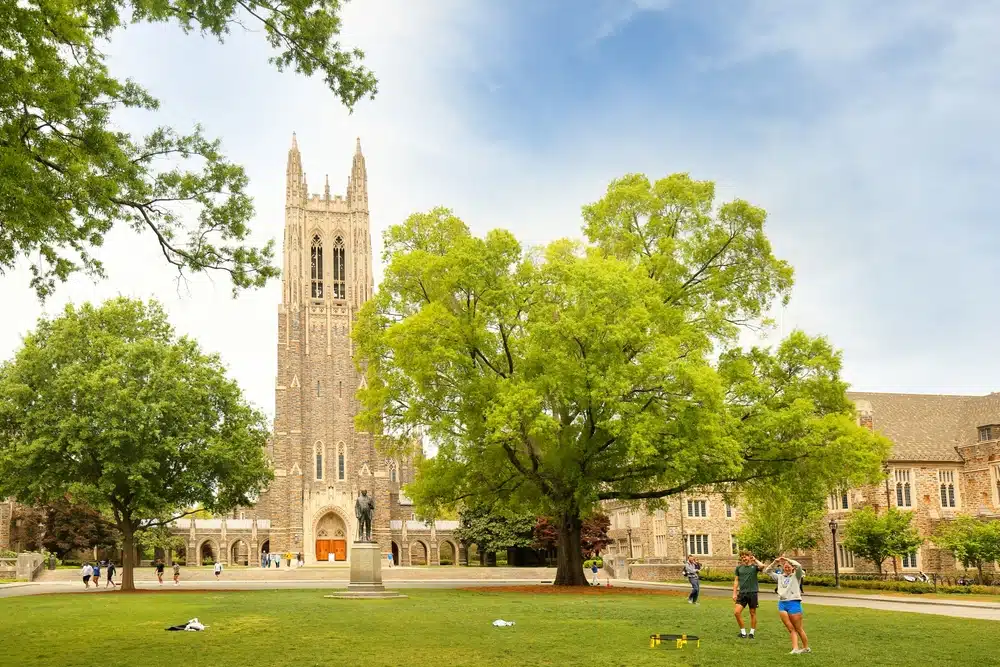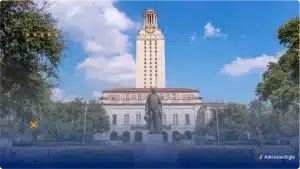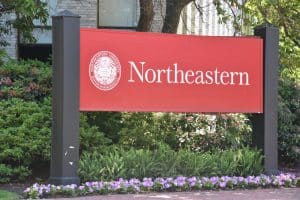What is the Yield Rate at Duke University?
In university admissions, the term “yield rate” holds significant importance. Especially for renowned institutions like Duke University, understanding and analyzing the yield rate is crucial. This article aims to delve into the concept of yield rate, its significance in college admissions, and its impact on Duke University’s admissions process.
Understanding Yield Rate in University Admissions
Yield rate refers to the percentage of accepted students who choose to enroll at a particular university. It is a metric that provides valuable insights into the university’s ability to attract and retain admitted students. Yield rate serves as an indicator of a university’s desirability, reputation, and overall appeal among prospective students.
When it comes to university admissions, there are many factors that prospective students consider before making their decision. These factors include the university’s academic programs, campus culture, location, financial aid offerings, and career opportunities. Yield rate helps universities understand how successful they are in meeting the expectations and needs of admitted students.
Definition of Yield Rate
Yield rate, also known as the enrollment rate or admission yield, is calculated by dividing the number of students who choose to enroll at a university by the number of students who received an admission offer. The result is then multiplied by 100 to express it as a percentage. A high yield rate indicates that a significant proportion of admitted students decide to enroll, while a low yield rate suggests a smaller percentage of admitted students choose to attend.
Let’s look at an example to better understand how the yield rate is calculated. Suppose a university offers admission to 1,000 students, and 800 decide to enroll. The yield rate would be calculated as (800/1,000) * 100 = 80%. This means that 80% of the students who received an admission offer chose to enroll at the university.
Importance of Yield Rate in College Admissions
In the competitive landscape of higher education, yield rate plays a vital role in shaping a university’s reputation and overall standing. A high yield rate signifies that the university’s admissions process successfully attracts and convinces qualified students to choose their institution over others. It also reflects positively on the institution’s academic offerings, campus environment, and student support services.
Universities with a high yield rate often have a strong brand presence and are known for providing an exceptional educational experience. These institutions can create a compelling value proposition that resonates with prospective students, making them more likely to choose that university.
On the other hand, a low yield rate may raise concerns about factors such as affordability, location, or institutional image. It could indicate that the university is struggling to compete with other institutions to attract and retain admitted students. This can lead to a negative perception of the university and impact its overall reputation.
For universities like Duke University, maintaining a healthy yield rate is paramount. As a prestigious institution known for its academic excellence, Duke strives to ensure that the students it offers admission to see the university as their top choice and subsequently enroll. Duke University invests in various initiatives to engage with admitted students, such as campus visits, personalized communications, and events that showcase the university’s unique offerings.
Duke University’s annual yield rate is a captivating metric in higher education, showcasing the intricate interplay of factors that influence prospective students’ final decisions. With a multi-faceted approach to admissions, Duke consistently manages to maintain a yield rate that dances in the range of 50 to 60 percent. This percentage represents the proportion of admitted students who choose to enroll at Duke, signifying the allure of its academic offerings and the palpable magnetism of its campus culture. Duke’s remarkable blend of intellectual rigor, cutting-edge research opportunities, and vibrant extracurricular activities has established it as a formidable player in the academic landscape, resulting in a yield rate that reflects the enigmatic and multifaceted choices made by each incoming class.
In conclusion, yield rate is a crucial metric in university admissions that provides valuable insights into a university’s ability to attract and retain admitted students. It indicates the university’s desirability, reputation, and overall appeal among prospective students. By understanding and analyzing yield rates, universities can make informed decisions to enhance their admissions strategies and improve their standing in the competitive higher education landscape.
Duke University: A Brief Overview
Before delving deeper into Duke University’s yield rate, it’s essential to have a brief understanding of this esteemed institution’s history and reputation.
History of Duke University
Duke University, located in Durham, North Carolina, was founded in 1838. Originally known as Trinity College, the university underwent a series of transformations before becoming Duke University in 1924. It was endowed by the Duke family, who sought to establish a leading research university in the South.
Throughout its rich history, Duke University has witnessed significant milestones and achievements. From its humble beginnings as a small Methodist school, it has grown into a world-renowned institution at the forefront of academic excellence.
Over the years, Duke University has played a pivotal role in shaping the intellectual landscape of the United States. Its commitment to fostering an environment of intellectual curiosity and innovation has attracted some of the brightest minds in the world.
One notable aspect of Duke University’s history is its deep-rooted traditions. From the iconic Duke Chapel, which stands as a symbol of the university’s spiritual foundation, to the lively basketball culture that permeates the campus, these traditions contribute to the vibrant and inclusive community that defines Duke University.
Duke University’s Reputation and Rankings
Consistently recognized as one of the top universities in the United States, Duke University commands immense respect within the academic community. It consistently ranks among the nation’s leading institutions in various reputable college rankings, including the U.S. News & World Report and Forbes.
However, Duke University’s reputation extends far beyond rankings and accolades. It is renowned for its unwavering commitment to academic excellence, fostering a culture of intellectual curiosity, and pushing the boundaries of knowledge.
At Duke University, students can learn from world-class faculty who are leading experts in their respective fields. The university’s commitment to research and innovation ensures that students are exposed to cutting-edge discoveries and breakthroughs that shape the future.
Moreover, Duke University’s reputation extends beyond its academic prowess. It is known for its strong sense of community and its dedication to service and social impact. Students at Duke are encouraged to engage in meaningful extracurricular activities, such as community service projects and advocacy initiatives, which further enhance their educational experience.
With its renowned programs in engineering, business, law, medicine, public policy, and the liberal arts, Duke University has established itself as a destination of choice for ambitious students seeking a transformative educational experience.
Whether through its rigorous academic programs, vibrant campus life, or commitment to positively impacting society, Duke University continues to uphold its reputation as a leading institution of higher learning.
Analyzing Duke University’s Yield Rate
Now that we have explored the fundamental aspects of yield rate and gained insight into Duke University let’s examine how the institution’s yield rate fares and the factors that influence it.
Duke University’s yield rate is a crucial metric that reflects the percentage of admitted students who choose to enroll at the university. A high yield rate indicates that Duke successfully attracts and convinces admitted students to join their academic community. On the other hand, a low yield rate may suggest that students are opting for other institutions or considering alternative options.
Factors Influencing Duke’s Yield Rate
Several crucial factors contribute to Duke University’s yield rate. The university’s strong academic reputation and commitment to providing an exceptional educational experience is a major draw for prospective students. Duke’s dedication to research, coupled with its renowned faculty, inspires prospective students to envision a rewarding academic journey.
Furthermore, Duke University’s commitment to fostering a vibrant and inclusive campus community significantly attracts students. The university offers various extracurricular activities, clubs, and organizations catering to diverse interests. This comprehensive approach to student life ensures that admitted students see the potential for personal growth and a well-rounded college experience.
Another factor that influences the yield rate is the university’s location. Duke’s picturesque campus in Durham, North Carolina, offers a vibrant community and an attractive quality of life, attracting students seeking a balance between academic pursuits and extracurricular involvement. The city of Durham itself provides a rich cultural scene, with art galleries, music venues, and a thriving food scene that enhances the overall student experience.
Moreover, Duke University’s commitment to financial aid, scholarships, and grants ensures that talented students from diverse backgrounds have the opportunity to attend. The university’s substantial financial aid packages significantly influence the decision of admitted students to enroll. By alleviating the financial burden associated with higher education, Duke University makes its education accessible and appealing to a broader range of students.
Comparing Duke’s Yield Rate with Other Universities
When comparing Duke University’s yield rate with other institutions, it’s essential to consider factors such as selectivity, academic offerings, and regional competition. Duke’s yield rate consistently ranks among the highest in the nation, showcasing the university’s ability to attract exceptional students.
However, it is essential to note that yield rates can vary depending on the programs, degrees, and the competitiveness of other universities. Comparative analysis of yield rates allows administrators and admission officers to gain insights into their recruitment strategies, enrollment projections, and how they fare against peer institutions.
Additionally, understanding the factors contributing to a high yield rate can help universities identify areas for improvement and implement targeted initiatives. By analyzing the strategies employed by other institutions with high yield rates, universities like Duke can refine their own approaches to student recruitment and enrollment.
Furthermore, regional competition plays a significant role in shaping yield rates. In areas with a high concentration of prestigious universities, such as Ivy League schools, yield rates may be impacted by students having multiple attractive options. This competitive landscape necessitates universities continuously innovating and differentiating themselves to attract the best and brightest students.
In conclusion, Duke University’s yield rate is influenced by many factors, including its academic reputation, campus community, location, and financial aid offerings. By understanding these factors and comparing yield rates with other institutions, Duke can continue to refine its strategies and maintain its position as a leading institution of higher education.
The Impact of Yield Rate on Duke University’s Admissions
Now that we have explored yield rate and examined Duke University’s specific context let us delve into the impact yield rate has on the university’s admissions process and overall policies.
How Yield Rate Affects Admission Decisions
Duke University’s admissions process considers yield rate when making admission decisions. Admissions officers carefully assess and evaluate a candidate’s potential interest in and fit with the university. Demonstrating a genuine interest in Duke University through application essays, interviews, and campus visits can positively impact an applicant’s admission chances.
Admissions officers strive to select students who they believe will thrive academically and meaningfully contribute to the campus community. A strong yield rate reflects positively on the admissions officers’ ability to identify candidates who align with the university’s values, mission, and culture.
Yield Rate and Its Influence on University Policies
As a renowned institution, Duke University continually relies on its yield rate data to shape and refine its admissions processes and policies. A high yield rate suggests that the university’s outreach efforts, recruitment strategies, and financial aid packages are practical. Conversely, a low yield rate prompts the university to reevaluate its approaches and make necessary adjustments to attract and retain admitted students.
Duke University’s commitment to maintaining a diverse and talented student body, both academically and culturally, also impacts its yield rate. The university actively seeks to enroll students from different geographic locations, socioeconomic backgrounds, and underrepresented groups, fostering a vibrant campus community.
Future Predictions for Duke University’s Yield Rate
Looking ahead, it is crucial to examine current trends and predict potential changes that may impact Duke University’s yield rate in the future.
Trends in Yield Rates
In recent years, there has been increased competition among universities to attract top-performing students. Consequently, yield rates at prestigious institutions like Duke University have become even more significant. The recent trend has gradually increased Duke’s yield rate, primarily due to its reputation, academic programs, and comprehensive support for admitted students.
Predicted Changes and Their Potential Impact
Anticipating potential changes in the college admissions landscape can help predict shifts in yield rates. Factors such as changes in financial aid policies, fluctuations in application volume, emerging academic programs, or growth in student preferences can impact Duke University’s yield rate.
Furthermore, demographic changes and societal shifts can influence students’ decision-making process. Duke University must adapt its strategies to maintain a competitive yield rate and attract exceptional students as the educational landscape evolves.
Final Thoughts
In conclusion, the yield rate at Duke University holds immense importance in the realm of higher education. It is a critical metric that reflects the university’s ability to attract and retain admitted students. Duke University’s exceptional academic offerings, strong reputation, and commitment to financial aid and diversity contribute to its impressive yield rate. By carefully analyzing and adapting to trends and changes, Duke University can maintain a high yield rate and attract the best and brightest students to its prestigious institution.
If you want to discuss the matter to a greater extent or inquire about college admissions, look no further! Our experts here at AdmissionSight can help you! Here at AdmissionSight, we have over a decade’s worth of experience guiding students through the competitive admissions process to get accepted to the top universities in the world. Feel free to set up an appointment today to book your initial consultation.









































